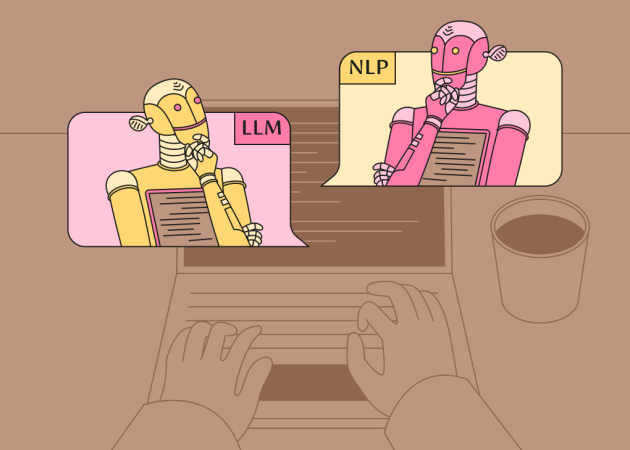
How to Choose a Tech Vendor for Your HealthTech Project: 9 Criteria (& Real-Life Examples)
Contents
Contents
In an industry as dynamic and impactful as HealthTech, selecting the right technology partner can be a make-or-break decision for innovative projects. Beetroot recently held an informative webinar dedicated to this very challenge, featuring Nick Tikhomirov, who leads our business development efforts in Europe and the UK, and Nikita Tkachov, the head of the Delivery team.
With Beetroot’s portfolio of tech partnerships with over 30 HealthTech organizations, our experts have been deeply involved in these projects. During the webinar, Nick and Nikita shared some real-life stories showcasing how specific vendor qualities helped address unique challenges in various client scenarios.
Below, we summed up the key priorities for HealthTech products across various development stages. As the key takeaway, we designed a practical roadmap to help you choose the right tech partner for your HealthTech project, avoiding common pitfalls along the way.
Understanding your product stage and outsourcing options
Let’s begin by assessing the current stage of your product. This will allow you to identify the best outsourcing strategies. As Nick points out, the approach varies depending on your product’s development stage:
- Ideation: At the ideation stage, companies may have a solid concept but lack detailed designs or a development roadmap.
- MVP development: This involves developing a Minimum Viable Product to test your concept.
- Post-MVP, commercial: Here, you have a commercial product and are planning further development phases.
- Scaling up: Companies at this stage are looking to expand their well-established product in the market.
Regardless of your product’s stage, four main outsourcing routes are available:
- In-house development: Directly hiring and nurturing talent within your organization.
- Freelancing: Utilizing platforms to find global contractors based on your location and budget.
- Hiring teams with partners: Engaging outsourcing or outstaffing vendors.
- Delegating projects to partners: Transferring entire projects or specific functionalities to vendors.
Now, let’s align these outsourcing routes with each product stage:
- Ideation and proof of concept: The best choices are in-house development or project delegation to partners.
- MVP development: Similar to the ideation stage, the focus is on in-house efforts or partner projects.
- Post-MVP commercial phase: All outsourcing options become viable at this stage.
- Scaling up: In-house development, team hiring, and project delegation are recommended for this stage. Freelancing may not be as scalable.
If your company lacks in-house technical expertise, merely backfilling positions might not be the optimal solution. As Nick Tikhomirov explained,
“Simply recruiting new employees for team extensions or augmentations might not be the best option because it leaves a technical responsibility gap in driving tech development. In a team extension setup, your vendor can’t take on this responsibility. Delegating the entire project to them can bridge this gap.”
The choice of outsourcing strategy should be tailored to your specific situation and requires a customized approach. Our past cases illustrate this point.
Case #1: Scaling with efficiency
An Indian HealthTech startup focused on chronic disease management used Clutch to find a vendor. They needed to scale their tech teams quickly, so they looked for vendors in specific geography with sensible rates, having limited their search to 500-1000 companies that could provide vetted and relevant candidates who could start immediately. With strong in-house tech knowledge, they prioritized bandwidth over HealthTech-specific competency.
Tip:
With over 6,000 healthcare software development firms listed on Clutch, choosing the right provider can be daunting. If you’re a scale-up with strong in-house tech and HealthTech expertise and management, you need a vendor with a versatile vetting process, short times to hire, and a big talent pool.
Case #2: Relevant domain expertise: a key to faster time-to-market
A UK-based provider of personal alarms for older people was looking for a vendor with strong domain-specific expertise, especially one that had worked with companies similar to them, runs their own Telehealth R&D, and brings up relevant boilerplates. Here’s what Nikita Tkachov shared about this cooperation:
“When they approached us, the timing was ideal. We’ve just released a case study on our recent R&D project — a telehealth app enabling nurses, medical practitioners, and family caregivers to monitor the health of elderly patients by collecting and displaying real-time telemetry data through an intuitive digital dashboard. Our domain expertise and ready-to-use boilerplates were instrumental in meeting their needs. By leveraging our experience and existing resources, we significantly reduced their development time and effort, ensuring a smoother and faster path to market for their personal alarm system.”
Tip:
A vendor’s domain expertise is crucial when you need to shorten time to market by utilizing the knowledge and boilerplates they’ve developed in the past.
Case #3: Embracing inclusive development
Diverse teams bring a variety of viewpoints to the table. In HealthTech development, the diversity of lived experiences is crucial for building accessible, inclusive apps, especially solutions for users with disabilities or specific health conditions. Does your potential vendor promote diversity and inclusivity in their hiring approaches and company culture? Do they actively involve diverse stakeholder groups in their R&D processes and product development? Real feedback, the cornerstone of user-centric design, helps improve the product’s quality, ensuring that it will meet the audience’s needs and expectations.
Tip:
Commitment to inclusivity is not just a checkbox. Every big HealthTech vendor that prioritizes equality and diversity collaborates with developers and people with different lived experiences because they can understand the needs of potential users better than anyone. Having such projects in their portfolio underlines your vendor’s practical approach and commitment to social impact.

Case #4: Aligning values for sustainable development
Sustainability is a broad concept that is increasingly important in today’s world. It encompasses environmental, economic, and social aspects. Finding a like-minded vendor who shares your values can greatly enhance your collaboration. We partnered with a Swedish startup focused on holistic care, addressing physical, behavioral, and social health needs. Our shared values around sustainability have been the cornerstone of this partnership, allowing the engagement to prove successful and go a long way.
Tip:
Consider a vendor’s approach to sustainability in development. Discuss long-term goals and how the partnership can contribute to sustainable solutions. The answer can help you gauge their commitment to sustainability and their long-term vision.
Case #5: Leveraging multidisciplinary teams
Success in HealthTech requires collaboration among diverse skill sets, including domain and accessibility expertise. While there’s a lot of skepticism about one-stop shops, if you establish a strong relationship with the right vendor who can handle several development services and provide dedicated teams, it can be more efficient than managing multiple providers. We experienced this with a Swiss non-profit organization focused on fighting AIDS, hepatitis C, and tuberculosis. For them, we developed the design, web app, website, and mobile apps, all under one roof.
Tip:
Although one size doesn’t fit all, having a tech partner capable of meeting multiple needs can place you in a strong position. But proceed with a one-stop-shop approach with caution. View all projects as different projects, and take time to ensure that a provider who brilliantly extends your team can create a good website.
Case #6: Engaging subject matter experts
A precision medicine intelligence company leveraged AI to interpret genetic data. Our collaboration with physicians and geneticists integrated their expertise into the product. After several months of successful work, they decided to expand the team. Apart from the technical specialists, Beetroot connected the client with a geneticist.
“This is probably one of my favorite cases,” Nikita commented. “While they succeeded in ramping up their engineering team with the vendor, they encountered a bottleneck when trying to fill unconventional roles, such as geneticists, within their in-house team. Surprisingly, after a few discussions, they hired a geneticist through the same outsourcing company that provided their engineers. So you can really check for the vendor capabilities to hire or involve subject matter experts with a scientific, clinical, and other background to help you streamline the product development process because they can sometimes do even more than you think.”
Tip:
Expert engagement is vital, especially in Health Tech. Evaluate a vendor’s ability to engage subject matter experts (SMEs) from various fields to ensure regulatory compliance and relevance.
Case #7: The importance of second opinion
Ensure your vendor can go beyond engineering with capabilities in business analysis, project/product management/ownership, and delivery management. As Nick Tikomirov explained,
“This comprehensive understanding promotes a product mindset across the organization, shifting away from a mere service mentality. While you might not expect an outsourced partner to be as passionate about your product as you are, their ability to deeply understand and translate this into meaningful development can offer valuable second opinions and innovative solutions to challenges.”
Tip:
Sometimes, a second opinion on product development can be more important than we think. Your tech vendor could be a reliable source for this advice.

Case #8: Navigating compliance and regulatory standards
A Swedish company developing AI-based software for detecting intoxication faced unexpected challenges when a compliance issue led to a two-month dispute with Apple, significantly delaying their application’s release. After researching the issue, we provided guidance on the missing requirements. The company then obtained the necessary certification, which resolved their App Store compliance problem. As Nikita Tkachov commented:
“Many industry experts agree that while a vendor should understand the certifications required for their client’s product development, they don’t necessarily need to hold every possible credential themselves. It’s important to note that each certification a vendor displays often increases their rates. The key is for vendors to have a basic grasp of relevant compliance standards and how they might impact the hiring process and development. When evaluating potential partners, focus on their comprehension of the specific standards applicable to your project. A vendor who demonstrates knowledge of these standards and their implications may be suitable, depending on your product and goals.”
Tip:
While compliance and regulatory standards like ISO, HIPAA, GDPR, and FDA may be mandatory for a HealthTech product, vendors don’t need to hold every possible certification. However, they should understand the relevant compliance standards for their client’s product development.
Case #9: Budget-friendly development options
Let’s say you have two providers: the cost difference is significant, but the first one corresponds to most of the criteria we discussed above, and the second one (with lower rates) barely checks a few boxes. Which of them would you go with?
Tip:
When choosing a vendor, consider the overall value rather than just the lowest price. Budget-friendly doesn’t mean the cheapest. It’s a trade-off between cost and quality. While it depends, of course, a sustainable partnership often justifies a higher cost if the vendor meets crucial criteria. Sometimes, it comes down to your view on things, values, and approach to sustainable development. At the same time, service providers have their margins to maintain the level of service they commit to.
Summing up the tech vendor selection criteria
Let’s summarize the vendor selection criteria we’ve discussed above:
- Ability to scale
- Domain expertise
- Commitment to inclusivity
- Sustainable development approaches
- Multidisciplinary teams
- Expert engagement
- Second opinion
- Compliance and regulatory standards
- Budget-friendly development options
Bonus: Download your RFP template
As a small bonus, we’ve created this RFP (Request for Proposal) template for you based on our industry experience, having encountered numerous RFP variations over the years. The template combines insights from both client and vendor perspectives, including all key criteria we’ve discussed, and can be fully customized. We designed this framework to help you clearly communicate your project needs and requirements to potential tech partners.
Shortlisting the right development services provider among the myriad of vendors on Clutch and other platforms may feel like looking for a needle in a haystack — daunting and almost like a lottery, especially with the regulatory and other healthcare-specific challenges. We hope that the real-life observations and tips we shared today, as well as our RFP framework, will help you better navigate the vendor selection process. And if you need help with building full-stack teams for end-to-end development, senior tech consultancy, or anything in between for your next HealthTech project — Beetroot experts are here to help.
Subscribe to blog updates
Get the best new articles in your inbox. Get the lastest content first.
Recent articles from our magazine
Contact Us
Find out how we can help extend your tech team for sustainable growth.







